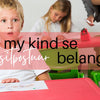Your child's handwriting: More than just a pencil grasp.

Poor bilateral hand use can influence a child's ability to write neatly.

What is Bilateral Coordination and why is it important?
Bilateral coordination is the ability to use both hands in a coordinated way while doing tasks such as cutting with scissors, writing, colouring, pasting with glue, and using a ruler or eraser. A child who struggles with the coordinated use of his/her hands will have difficulty with various activities in the classroom and it will impact their ability to work neatly.
Bilateral coordination is also important for successful execution and participation in activities such as self-care (tying your shoelaces or eating with utensils) and sport and leisure activities (playing sports, riding your bike, or playing with a jump rope).
What does it look like?
Children who struggle with bilateral coordination might present with the following difficulties in the classroom:
- do not stabilize the page while writing
- difficulty drawing lines and using a ruler
- struggle to stabilize the page while using scissors and cutting
- struggle to sharpen pencils, using an eraser or a glue stick
- difficulty with folding and tearing activities

_______
Poor Bilateral Integration May Lead To:
Fatigue, frustration and slow work speed.
What can we do?

What can we do at home?
Our Products
The Complete Number Bundle
The product was developed to prevent the reversal of numbers when writing. Aimed at foundation phase learners, this program focuses on teaching the correct method for forming each of the numbers utilizing an animation video and worksheets for consolidation. It includes the story of numbers 1 to 10 as well as a strategy for the prevention of reversal of numbers 2, 3, 4, 5, 7, 9, and 10. Presentation is practical, child-directed, and lots of fun.
Fine Motor Development Activities
The Tricky Fingers fine motor program consists of a series of fine motor activities to develop the muscles of the hand and support development of a dynamic pencil grasp. The program includes printable activities, a video demonstrating the desired finger movements and execution of each activity. The activities are fun, easy to prepare and low cost.
_________
For more information.
Follow our Facebook page for regular activities and ideas to enhance your child's development or visit our online store to view our educational and therapeutic resources.








